It took us a relatively slow forty minutes to get completely set up to begin climbing. By then, the other two parties had already started off, which - to be honest - was fine by us. There seemed to be no one coming up behind us, and we would as a result not need to feel pressured from behind.

Starting the Climb
As I see it, the winter Trap Dike route has several notable points: a short slope up to a step of ice climbing; then a stretch of moderately steep snow within the walls of the Dike; then another step of ice climbing, followed by another stretch of moderate ascent, again within the [now-diminishing] walls of the Dike. When the walls get low enough, one exits right, out onto the face of one of two steep and open slide faces. These faces are followed directly upwards to the summit.
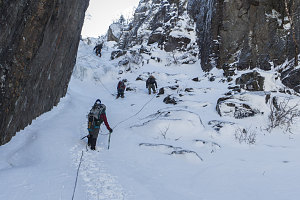
Climbers Ahead
A few minutes of snow climbing brought us to the base of the first ice step. Already, we could see the effects of the 2011 slide. It had removed all of the brush and small trees that had been growing in the floor of the dike. There were now only a few scraggly remnants of the former vegetation.
Seeing as we had to wait for the party ahead of us to complete their ascent of the ice step - and in the interest of practice - Roland cut a ledge out of the snow slope below the step and set up a formal belay station. We all then gathered there for a few minutes until the party above had cleared out.
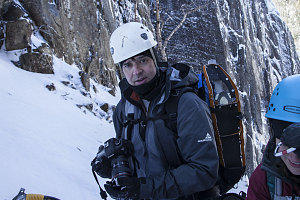
courtesy RHanel
The climb of the first step went reasonably quickly, and soon we were atop it, re-organizing the ropes and getting ready for the hike up to the next ice step. One of my crampons had partially detached partway up the ice; this was the first time using these crampons with the particular boots I had on today, and clearly the fit wasn't perfectly worked out yet. Probably I should have just worn my plastics, at least until I had worked out these fitment glitches. A bit of a mistake.
We decided that we'd go with a "running belay" from this point: a technique that uses climbing protection but without a fixed belay point. Bottom line: faster progress but while still maintaining some safety against an uncontrolled fall or slide.
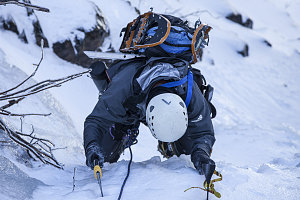
courtesy RHanel
While prepping for the switch to a running belay, I turned while placing my ice ax into the hard snow. The shaft did not sink in, however, and glanced sideways, starting it sliding downslope. I made a quick swipe for it, but - being attached to an anchor - it was just beyond my reach. I watched helplessly as the ax slid over the top of the ice step and clanked and clattered all the way to the bottom. It then slid for some ways down the steep and icy slope below, before being stopped - fortunately - by a thin patch of soft snow. I apologized profusely to the others for my careless mistake - mistake number two....
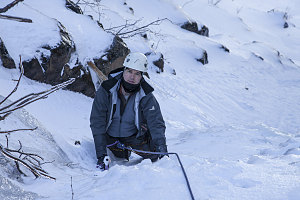
courtesy RHanel
Recovering from a mistake
Roland and Stephanie were very gracious about it all, fortunately, and took this time-wasting mishap quite well. For me, however, there was now penance: I had to retrieve this very important fallen piece of gear.
Rather than directly test the strength of our belay's snow anchors, we decided to have me downclimb the ice step (rather than rappel), then back down the slope to where the ax had stopped. Fortunately, this was less than the length of our rope, so we didn't have to mess with our already-established rope setup. Down I went, carefully climbing backwards until I reached it. Very grateful that this had happened at a spot where the ax hadn't gone too far, I carefully stowed it away and re-climbed back up the slope and ice step to the others. And apologized one last time.

Nearing second ice step
With that mishap out of the way, we began our running-belay ascent upwards. The scene was all snow and rock: the Trap Dike's walls formed a snow-floored, canyon-like corridor that led ever upwards. Fifteen minutes or so later, we arrived at the base of the second ice step. Owing to our general slowness and my ice-ax-dropping mishap, the climbing group above us was nowhere to be seen.

Step 2
The second ice step was surmounted with little difficulty. The step seemed shorter than when I last did a winter climb here - likely owing to the late-season (and therefore deeper) snowpack.
Up until now, we had been climbing in the shady confines of the Trap Dike's walls. As we ascended, however, the walls gradually lowered. Combined with the higher angle of the sun, we were now mostly in full and brilliant sunshine.
We had expected the snowpack to soften up with the warming of the day and with the direct rays of the sun, but as we continued our climb beyond the second step, the surface was as hard as ever - moderated only occasionally by a smear of fresh snow atop a concrete-hard layer.

courtesy RHanel
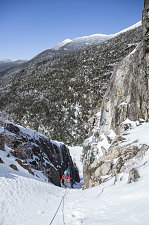
courtesy RHanel
Starting climb of 2nd step
The continuously-hard snow conditions meant we couldn't kick steps in the snow. This was quite a bit more tiring than one would expect; instead of placing your foot deep into the snow and then standing with a relatively flat foot-angle, you had two choices: either front-point - with just the toe-spikes of your crampons piercing the surface, or flat-foot - bending your foot to maintain flat contact with the angle of the slope. Both of these choices can be uncomfortable if you have to do them for a sustained period of time - which was definitely becoming the case here: we had been front-pointing and/or flat-footing for several hours now.
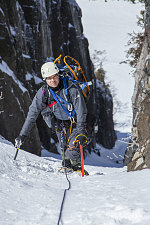
courtesy RHanel
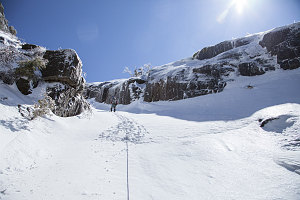
courtesy RHanel
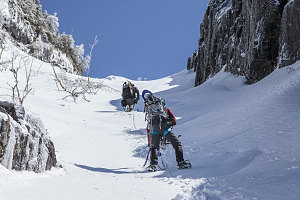
courtesy RHanel

courtesy RHanel
It seemed to take forever to inch our way to the upper part of the Dike, where the "exit" locations onto the upper slides are located. With the super-hard surface conditions, we moved cautiously, and continued to place protection at intervals. Finally, shortly after 2pm - and way beyond my estimated schedule - we arrived at the top end of the [open part] of the Trap Dike. Ahead, the notch of the Dike was filled in with trees.
